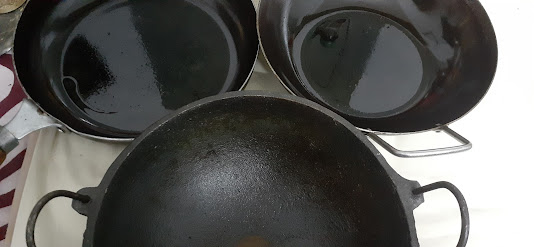Choose your vessels carefully (along with instructions to season cast iron and pure iron)
I love my gastronomical time; the aroma and vibrancy of spices and herbs—and, of course, the joy of cutting and stir frying vegetables and savouring good food with family and friends—are so enthralling that they transport us to another world, transiently.
Like most beginners, I started with non-stick vessels. I then shifted to granite vessels without being aware of the perfluorooctanoic acid (PFOA) coating on such vessels. The presence of PFOA have been linked to thyroid, kidney and liver diseases. Although, it is worth noting the research discussed in healthline.com, which clarifies that the Teflon coating in new vessels are PFOA free. Similarly, there are several concerns over aluminium vessels. To understand the concerns, I skimmed through an article in the National Medical Journal of India that clarifies that the amount of leaching of aluminium in hard anodised aluminium vessels is equivalent to leaching of metals in stainless steel vessels. Although, please note that aluminium leaching is toxic as compared to leaching in nickel-free stainless-steel vessels. Hence, purchasing good food grade—preferably branded—vessels is one right step. Secondly and more importantly, drinking sufficient warm water as per body weight and consuming nutritious food is important, as well.
As per accepted understanding, stainless steel, pure iron, cast iron, enamel coated granite, ceramic, clay and glass are considered the best materials for cooking vessels. Enamel coated granite and ceramic are on the expensive side; hence, I opted for stainless steel, iron and clay for cooking—and glass for baking. Talking about stainless steel, prefer nickel-free.
- First, please immerse the iron vessels in a tub filled with starchy rice water for 7 hours;
- Water leftover from cooking rice can be diluted and added (Avoid these two step if the vessels are new and seasoned);
- Wash the iron vessels in water;
- Dry them completely with a kitchen towel;
- Apply oil over them—both over the top and bottom;
- Heat them on medium flame for a minute;
- Dip the bottom of half an onion in oil, prick the upper portion with a fork and apply it on to the upper part of the vessels in circular, horizontal, vertical and diagonal motions for 5 minutes.
- Begin with this step of onion seasoning each time before cooking;
- To clean, add some water and heat. Scrape and throw the stuck food particles off and drain the water; usually, there wouldn’t be any, post onion seasoning;
- Clean the vessels with mild soap--or salt and warm water;
- Dry the vessels, apply oil and heat for a minute or two and store in a dry place.



Comments
Post a Comment